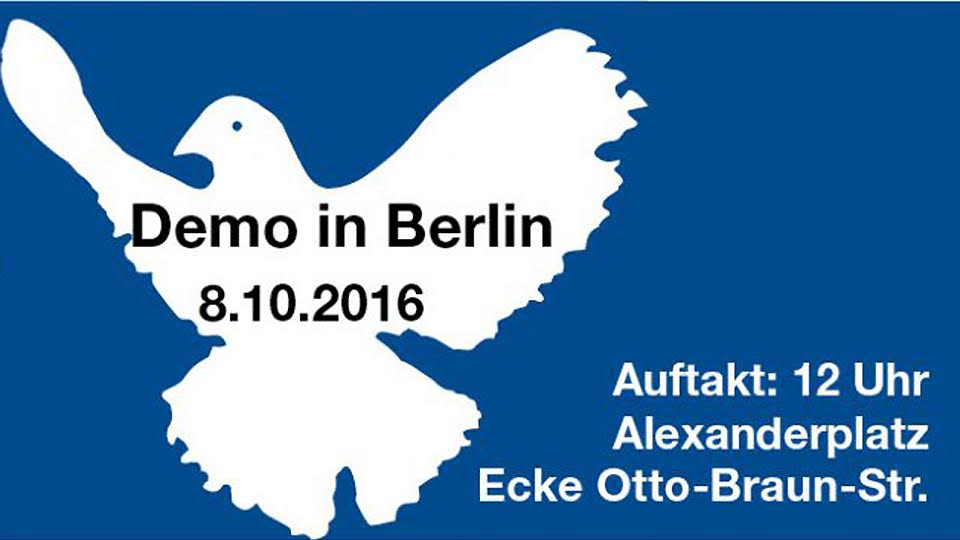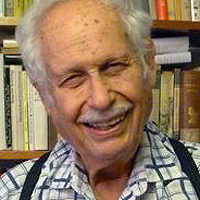
BERLIN — On Saturday, near my Berlin home, I joined a colorful, long-planned, all-German demonstration for peace. Pushing through the 7,000 to 10,000 participants toward the speakers’ truck at the start-off square, East Berlin’s Alexanderplatz, I met many friends and saw earnest, enthusiastic groups from the Turkish, Kurdish, Iraqi and Afghan communities. After an hour or so, when the sound trucks and the long banner-waving crowd wove their way through downtown East Berlin to Brandenburg Gate (where the US Embassy is also situated), it could hardly be ignored – except by reporters from most of the main newspapers, who somehow seemed too busy elsewhere.
An important plus point had been achieved: leading German peace organizations had united to plan it, overcoming splits and schisms which sadly weakened the movement in recent years. Also among a long list of sponsors were the executive committee of the LINKE party (a definite achievement), peace organizations of doctors, lawyers and teachers, associations of anti-fascists, national and international, the action organization Attac, the German Communist Party, and other leftist groups, various youth organizations and even the remnants of the Pirates Party in Berlin.
Missing
Though bigger than any peace protest for years, it was nowhere as large as it should have been considering the cliff-hanging war or peace situation in the world. A year ago an amazing crowd of about 320,000 had demonstrated in Berlin against the TTIP trade deal with the USA (the European copy of TTP); only three weeks ago the same number marched on one day in seven cities against a similar treaty with Canada (CETA), with 70,000 in Berlin; ten times this Saturday’s crowd. Missing this time were the big, central labor unions. Not many Germans want more boots on the ground or bombers in the air in far-off places, but too few, even among labor leaders, see the war menace affecting them personally, especially when jobs are involved. Also missing were endorsements from the two parties which some count as “left of center” – the Social Democrats and the Greens.
A few reefs also troubled the waves. A main cause for the past split was the accusation that covert rightists, pro-Nazis and anti-Semites had latched onto the peace movement, thus compromising it. The names of a few dubious or controversial people served as evidence. But it seemed a hopeless endeavor on Saturday to grill (and perhaps exclude) each one of the thousands on their inner beliefs or prejudices. There were rumors of a tiny, flopped counter-rally, and a reporter or two did even discover one, but where I was no such types dared show themselves, and every speaker sharply rejected all such views. This issue, once so damaging, was now, if anything, only a tiny ripple.
Disagreement
There is still disagreement about whether to lay the main blame for the tragic events in Syria, the Ukraine or elsewhere on NATO, led by the USA and its German military sidekick, or to share out the blame equally on NATO and Russia with its support for Assad and East Ukrainian breakaway regions.
Most of those at the rally clearly favored the former approach, with many hand-made posters stressing how NATO had pushed its military forces to an almost total encirclement of Russia, from Estonia, Poland, Bulgaria, Romania, to the Ukraine and Georgia. Some slammed the deployment of German planes and troops to the Baltic countries near St. Petersburg and recalled the horrifying siege of then Leningrad by German troops 75 years ago, with well over a million civilian deaths. But one big banner equally blaming both sides was steered by its stalwarts to a spot in the front, with no objections, and when a main speaker, a psychotherapist with experience in Syrian war areas, blamed both sides she got some whistling and even catcalls at first but then a willingness by everyone to hear her views: “…We need a much stronger UN as mediator, able to draw in all parties to the conflict in Syria, also Iran and the Kurds, to work out a military truce…Both world powers must use the necessary pressure on their military partners, on the Assad regime and on the Islamist militias of the Al-Nusra front… We need intense and constructive cooperation between the USA and Russia, with justified criticism of both major powers by us in the peace movement.”
In a fiery speech at the closing meeting, Sahra Wagenknecht, co-chair of the LINKE (Left) caucus in the Bundestag, also stressed that all war was immoral, no matter who conducted it. But she bashed those major party Bundestag deputies who suddenly discovered their resistance to war crimes after news from Aleppo – and denounced only Assad, Putin and the Russians. Where were such critics, she asked, in all the years when Afghanistan was being torn apart, also by German troops? Where were their hearts during the killing supported by Saudi Arabia, Qatar and Turkey? Why have they never opposed sending military support or weapons, not just to Afghanistan but to Iraq, Libya, Syria, Yemen, Mali und the Ukraine. Our party stood alone in the Bundestag in voting “No” – and will keep up its opposition. She said that Saturday’s protest was a good new start but must grow far larger.
Demands
Three demands on the Bundestag emerged from the rally:
Instead of 40 billion Euros for military expenses planned for 2017 and huge new sums demanded by Defense Minister Ursula von der Leyen for a dozen more years, including a “modernization of atomic weapons stationed in Germany” (called “total insanity” by Sahra Wagenknecht), most of the money should be spent on social improvements, on schools and senior care and for urgent ecological needs.
Soldiers and sailors of the German Bundeswehr, whose deployment in too many conflicts has never improved any situation but always added to disaster, should be brought home and kept home.
German weapons, large and small, sold by the billion, especially to the Middle East, should no longer be exported, and most especially not to conflict areas, where they had so often heated things up.
Berlin
These matters were of little concern in Berlin’s local scene where, for the first time, three parties are needed to reach a 50 percent majority in the 160-seat legislature and form a government. The Social Democrats took a terrible beating in September’s vote, their worst since the war, but still have a lead and will again hold the job of mayor. Their erstwhile Christian Democrat partners took an even worse beating and will no doubt be out of governing for a while. Included for the first time will be the Greens, who took a small beating, and the LINKE (Left), one party which gained votes. All three must now agree on a program and decide on who gets which cabinet positions (called Senators).
In nearly every photo the leaders of the LINKE smile happily at such chances. But here, too, some reefs threaten. Whenever the LINKE joined a state coalition it ended up weaker than before. A basic reason is clear: many East German and East Berlin voters gave it their votes because they saw it as a force opposing politicians who so often disappointed them. When the LINKE is in a government it is hard to see it as opposition. It may win some improvements, usually under-reported by the media, but it can hardly fight measures it has officially agreed to. Even when out of power it tried to gain or regain “its share”.
Far-right AfD
This created a gap filled only too willingly, and dangerously, by the far-right Alternative for Germany (AfD), which far too many see as a genuine opposition, despite its program of helping the wealthy and hurting the hard-up, of supporting a renewed draft and military strength, though separate, for nationalist reasons, from the European Union and the USA. But who reads programs? As with Americans backing Trump, insecurity, worries about jobs, prices and the future plus primitive, media-fed hatred of allegedly favored “others” – refugees, Muslims, “furriners” in general, are channeled by the AfD into nasty parades, some violence, and electoral support now at about 14% in Berlin and nationally, and well over that in some East German states.
If only the LINKE could respond to those worries instead of the AfD and be a real, militant street-active opposition, outside and inside the parliaments, if it could borrow tips from Bernie Sanders’ amazing fight or Jeremy Corbyn’s campaign in England it might gain more ground and push back the AfD. When it does act this way, as newly in the western boroughs of Berlin, it gains the most.
But if it prefers to be oh-so moderate and willing to compromise in hopes of joining a triple coalition next year on a national scale like that now shaping up in Berlin, it can suffer more big flops, as in a series of state elections. And if, as some seem to wish, it gives up the demands voiced by Sahra Wagenknecht and instead says “If you’ll let us join we would then OK one or two little deployments abroad, but only, of course, if they’re again called humanitarian” – then, alas, it could follow the same roller-coaster descent as the Social Democrats, who have approved all such moves, or the Greens, whose strong right-wing is more gung-ho than ever, and is now busy improving its close relationship with Daimler-Benz and similar notably so very humanitarian institutions.
But in a Germany now facing many economic reefs, with Volkswagen floundering and even the mighty Deutsche Bank getting nailed for its crooked endeavors, the seas can get mighty turbulent – and a fighting, well-aimed party like the LINKE would be more necessary than ever before.










